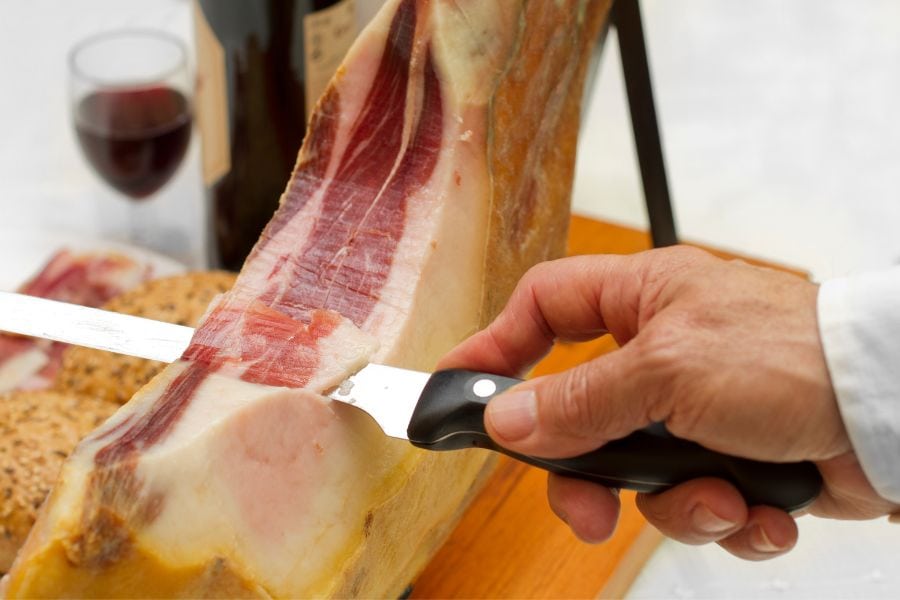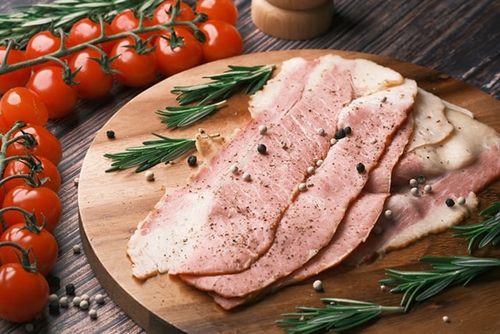Ham and pork differ in a number of ways including appearance, flavors, shelf life, and more.
Ham vs. pork may seem like such a simple subject, but it isn’t. I had to learn the intricacies of pork and ham in culinary school so I am something of an expert!
In this post I will break down what each type of meat is, outline their differences, and give you even more info. So, let’s dive in!

Now, if you imagine that the main difference between ham and pork is that it is from two different types of animals, think again. They are both from a domesticated pig and, as such, are considered pig meat.
However, pork refers to all meat that is derived from a domestic pig. Ham, on the other hand, refers to the meat taken from a pig’s hind leg – or, in easier terms, the leg of the pig. So, if you want to get philosophical about it, you can say that all ham is pork, but not all pork is ham.
As ham is a cut of pork meat, you would technically not be wrong to refer to ham as pork ham.
There are technically three types of ham – there is fresh ham, cured ham, and smoked and cured ham. This can further be divided into country ham, gammon, black forest ham, honey glazed, York, Limerick, and more.

In general, though, ham is considered a cured pork product as it most often undergoes, either dry or wet curing, although it can be smoked as well.
As for fresh pork, there are several cuts of pork derived from this raw meat. This includes pork chops, pork tenderloin, pork loin, pork butt, ham hock, and pork shoulder.
Once treated, it can also be found in other forms such as bacon, salami, etc.
Related Reading
In terms of health, is pork or ham a healthier option?
Well, as with pork, ham has a higher protein content and can be low in calories as well. It also contains numerous other nutrients, each with has its own health benefits.
However, this doesn’t necessarily mean that ham is healthy. This is because the curing and smoking processed used in ham can result in carcinogens such as sodium nitrate. There are also other food additives thrown into the mix with this cured meat.
At the same time, this food is very high sodium content. Not only is this bad for most people, it can also cause flare-ups of certain chronic conditions.
These issues aren’t associated with raw pork as it isn’t processed at all. Of course, these disadvantages aren’t present with fresh ham either.
In general, though, it is best to consume pork in moderation and to eat ham occasionally.
Related Reading
Now let’s break down the real components of ham vs pork:
Ham and pork meat look quite different to one another. In particular, there is a variation in color. When sold in raw form, pork is often pale pink. This does depend on the specific cut of pork, though.
Leaner cuts such as pork tenderloin and pork chops are lighter in color. Cuts like pork butt, on the other hand, have a higher fat content and will be darker.
Related Reading
The manner in which ham is processed causes a change in its appearance. It is often a deep pink and the meat tends to be darker. Depending on the variety, the exterior may be glazed and you may be able to see notes of pink and orange as well.
Then, there is the tastes – both pork and ham have a unique flavor each.
In general, pork has a rather mild flavor. This is why it is often cooked or served with marinades or sauces. A higher concentration of fats can cause the pork to have a stronger flavor, though.
Ham certainly has a more rich flavor and is considered to be more flavorful than regular pork. It should be noted that each type will have a specific flavor profile that depend on what type of processing it underwent.
As such, the ham taste can be a smoky flavor, a sweet one, or take on the flavors of its dominant seasonings.
As you are probably already aware, ham has a longer shelf life. This, of course, is because ham has been prepared specifically to last for longer.
Most hams can last several days when refrigerated. If it is a dry cured ham, it can actually last for weeks at a time.
It is an entirely different story with fresh or raw pork. Once sold raw, it needs to be cooked immediately. If you aren’t planning on cooking it right away, then you will need to store it in the freezer.
Evenly freshly cooked pork has a relatively short shelf life.
Most smoked or cured and salted ham is in ready to eat form. This is especially true for deli meats. Ham that hasn’t been processed still needs to be cooked, though.

Now, ham especially glazed ham can be the star of the show for meals. It is just as likely for it to be consumed in a ham sandwich, added to soups, eaten in salads, and more. It is quite a versatile addition.
However, when it comes to preparation, I would have to admit that pork wins this particular category. You can make everything from pulled pork and pork chops to pork roasts. There is really no end to how you can use raw pork meat in making pork dishes.
You should also remember that it can be used to make sausages, burgers, meatballs, and more.
You should also be aware that there is a difference between ham and pork when it comes to cost. On average, raw pork tends to be cheaper. This, of course, is because ham has to be cured and salted first and, thus, is more expensive.
Well, this is a bit of a tricky question as the answer all depends on what you are making. In the case, of salads, soups, and sandwiches, sure you can swap out pork for ham without any issue.
However, while fresh ham may work for some pork recipes such as pulled pork, there is a limit to how it can be used. This is especially true for smoked or cured ham.
Now, when swapping out raw meat with ham, you do have to consider the taste difference between ham and pork. As mentioned, pork is more mildly flavored. Thus, your dish may feel like you are lacking something.
To add to this, you have to cook the pork first before adding it to the dish that you are preparing. Thus, it requires additional work.
Technically, if you have the right recipe, tools, and ingredients, you can make your very own ham with the right cut of meat.
You should be aware that this process does take a great deal of knowledge, skill, and practice. Not to mention, it takes quite a while. You can certainly give it a try but you will find it easier – and cheaper – to just pop down to the nearest deli and purchase your favorite type from there.
Another question I am asked often is the difference between ham and prosciutto.
Well, there actually isn’t any difference – they are one and the same! Or rather, prosciutto is a type of ham – a very special ham, in fact. It is the Italian word for an uncooked dry cured ham.
What sets prosciutto apart from the rest of the hams is that it is considered an artisan meat. This is because a great deal of effort, skill, and process goes into producing this type of ham. As a result, it has a gorgeous and unique flavor. To add to this, it is also quite expensive.
Now, if a recipe calls for prosciutto, can it be substituted with another type?
In most cases, I would advise against it. This is because prosciutto lends something truly special to any dish that you add it to. It is difficult to replicate this element with other types of hams.
The same goes for subbing out regular ham with prosciutto too. The texture and saltiness of this delicacy will not work as well for sandwiches, soups, etc. Thus, it is best to follow the recipe instructions.
Related Reading
So, when it comes to ham vs. pork, they are some similarities – the meat comes from the same animal. However, while all ham is pork, not all pork is ham.
The other differences between ham and pork are their appearance, flavor, and how they are used in various dishes and recipes.
As you can see, there is quite a distinction between the two but now you are all caught up to speed. At a glance, you will be able to differentiate between the, something that can be quite useful at the deli and meat counter. Even better, though, you will know exactly how to use each cut!
The only thing that is left for you to do is to go ahead and try your hand with both ham and pork!